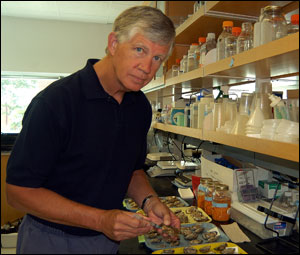|
Burreson Receives Mathias Medal

Photograph by Michael W. Fincham
EUGENE M. BURRESON, A VIRGINIA BIOLOGIST who pioneered studies of parasites that decimated oysters in the Chesapeake Bay, is the latest recipient of a rare honor, the Mathias Medal.
The medal, sponsored by Maryland Sea Grant, Virginia Sea Grant, and the Chesapeake Research Consortium, has been presented every five years or so to a retired scientist who has made significant contributions to science and policy in the Chesapeake Bay. The medal is named for former U.S. Senator Charles "Mac" Mathias of Maryland, who launched the first federal-state partnership in the 1970s to restore the Bay.
Burreson retired in 2010 from the Virginia Institute of Marine Science (VIMS) as a professor after 34 years there. His unique contribution to shellfish pathology, monitoring oyster diseases, and providing information critical for developing oyster-management strategies has had an enormous impact on the Chesapeake Bay.
In 2000, he and a colleague published a landmark work of scientific sleuthing that pinpointed for the first time the source of the protozoan parasite that causes MSX, a disease that helped reduce oyster stocks in the Chesapeake to one percent of historic levels. Burreson used genetic fingerprinting to show that the DNA of the MSX microbe found here matched that in parasites found in Japanese, or Pacific, oysters (Crassostrea gigas), which apparently were imported to East Coast waters starting in the 1930s.
Burreson also developed molecular tests that are used worldwide to detect shellfish pathogens and trained scientists to use them.
"Gene's contributions clearly rank with the very best in shellfish biology over the past century," said Roger L. Mann, director of research and advisory service at VIMS.
Since the Mathias Medal was established in 1990, only five have been awarded, the most recent to Grace Brush, in 2004. Burreson was to receive the award at a ceremony in Richmond in October.
|